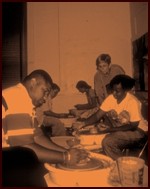


|
The YouthARTS toolkit was originally designed as a print book with a companion video and diskette. The kit is no longer available in print, but this website was designed to take the kit's information and make it available to the broadest possible audience. BackgroundSeveral existing publications do an excellent job of describing the achievements of arts programs designed for youth at risk, and information on artist training recently has been published as well. However, arts agencies, juvenile justice agencies, social service organizations, and other community-based organizations need more detailed information about how to plan, run, provide training, and evaluate arts programs for at-risk youth. The materials in this toolkit are designed to help. The toolkit contains the many lessons learned in Portland, San Antonio, and Atlanta about establishing, maintaining, and evaluating arts programs for youth at risk. These materials can answer your questions about how to plan, implement, and evaluate an arts program for youth at risk. The toolkit presents not only what worked well for the YouthARTS participants, but also what could work better—and, finally, what doesn�t work very well at all. The siteThe four main chapters in this site and the original handbook reflect the main tasks involved in implementing youth programs, and within each chapter we compare and contrast the experiences at each YouthARTS site. The full text of the original handbook is available for downloading as a PDF. Each chapter is also available separately. The various sections of this site summarize the book's contents, but we encourage you to read the entire package to get the full benefit. The sections include:
It is important to realize that these tasks—planning, training, evaluating, and budgeting—do not happen sequentially. You will, for instance, need to consider your training and evaluation needs while planning your program activities and developing your budget. In addition, we've provided a list of best practices, a glossary of frequently used terms, as well as appendices that have useful documents, including evaluation forms and sample curricula (see below). There are many ways to use this handbook. You might read through the entire text to get the "big picture." Then, once you have gained a general understanding of how the various steps of planning, implementing, and evaluating your program fit together, return to the various sections for more detailed information. Or, you can read through the checklists at the beginning of each chapter in the PDFs. These lists can provide you with a quick index of information that might be new to you, or help you locate a specific area that you are working on in developing or refining your program. If you choose to do a fast "thumb through," watch for the key symbol and "lessons learned" that appear throughout the handbook. The key symbol indicates key findings of our research—findings that might be new information or a new way to look at a challenge you may already have encountered in operating a program. The lessons learned (look for these in sidebars within the Team Training chapter) may keep you from traveling down a path that we found created more problems than it solved. At the end of each chapter in the PDFs we list "Best Practices from the Field," and a section entitled "Other Resources," which contains additional references for you to consult. The AppendicesAll appendices on the diskette that accompanied the original handbook are available on this site for downloading individually or as a package. When you see the disk symbol throughout the PDFs of the original book, intended to remind you to consult the diskette, go to the appendices instead. |

|
||||||||||||